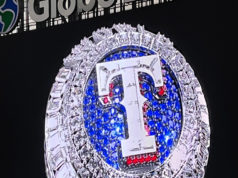With the Super Bowl over and the Patriots champions thanks to an epic comeback, I’m here to help you with your post-football hangover by easing you into that other football that’s going on all over the world. The winter transfer window for soccer closed this past week, and as usual, a fair number of players wound up changing teams. I’m here to answer all your questions that I just made up for you. Let’s start with:
What is the transfer window?
Every year has two periods during which teams can purchase players on the rosters of other teams. One is in July and August, the offseason for most soccer leagues worldwide. The other is in January, when teams look to buy players for a championship push or a fight against being relegated to a lower league. Alternatively, they might try to get rid of players who want to leave for whatever reason or sell the ones whose contracts expire at season’s end rather than lose them for nothing when those contracts run out. A player gets transferred when the two teams involved agree on a fee for him. Then the player and his new team negotiate a new contract.
What determines a player’s transfer fee?
How good he is, mainly, but also how desperate a team is to buy or sell him, how much money the purchasing team has to spend, whether more than one team is bidding for his services, and how much time is left on his contract. If a player extends his contract with his current team (like USA attacking midfielder Christian Pulisic did with his German club, Borussia Dortmund), it lowers the odds of his moving soon afterwards.
Why don’t some people like the midseason window?
Many people prefer to move personnel during the offseason, when there’s more time to target a team’s needs and complete deals, with no games being played to distract from business. Of course, the English club Manchester City got one of the best players in the world (Belgian attacker Kevin de Bruyne) during midseason, so anyone would jump if another chance like that presented itself.
Who made the biggest moves in this last transfer window?
Shanghai International Port Group FC sent $64 million to English Premier League-leading Chelsea to buy their underappreciated Brazilian attacking midfielder Oscar, ranking as the 10th most expensive transfer in the sport’s history. Only last June, SIPG spent $60 million to purchase Oscar’s Lou Ferrigno-looking Brazil teammate Hulk.
These Chinese teams are suddenly outspending everybody, even though the government just passed regulations to rein that in. What gives?
Like many of his compatriots, Chinese president Xi Jinping likes soccer and wants his country to succeed in the world’s most popular sport, something they haven’t been able to do. To that end, he’s telling owners in the Chinese Super League to invest in their clubs. The owners listen because many clubs like SIPG are owned by companies that are backed by the Chinese government. Even rich European clubs like Real Madrid and Bayern Munich will have trouble competing with the money of a billion taxpayers. The hope in China is that importing expensive foreign talent will encourage the development of local players until the Chinese national team stops sucking.
Can they do it?
I’m skeptical. They are buying stars in their prime rather than legends on their last legs, but otherwise, they’re making the same mistakes made by American owners during the spending boom of the 1970s and Middle Easterners about 10 years ago. They’re buying up only offensive players.
What’s wrong with that?
It’s kind of like an NFL team splashing out big bucks on an elite quarterback and receivers while playing only scrubs on their offensive line and defense.
Ooh. Doesn’t sound like a recipe for success.
Then again, for these owners, currying favor with the head of state may be more important to them than putting a winning team on the pitch, and buying high-profile players is a relatively easy way to do it. Just remember: It all goes away if Xi wakes up tomorrow and decides China’s energies would be better spent amassing the world’s greatest collection of Uno players. In the meantime, the Chinese team Changchun Yatai gave the English club Watford $25 million for Odion Ighalo, a Nigerian striker who scored all of three goals in his last 36 games.
Damn! Which Elton John song did they play at Watford to celebrate that?
Probably “Goodbye Yellow Brick Road.” Sir Elton is a lifelong Watford fan who has a section of seats at their stadium named after him.
What else happened in England?
Not much at the upper end. With Chelsea leading the rest of the league by a considerable margin, their main rivals at Tottenham Hotspur, Arsenal, Liverpool, Manchester City, and Manchester United all stood pat. Liverpool’s weepy, heavy metal-loving hipster-geek coach Jürgen Klopp was desperate to reinforce his team’s thin bench but could get only a third-string goalkeeper. On the other hand, Middlesbrough’s eternally grumpy Spanish manager Aitor Karanka saw the new players his front office brought in for him and promptly gave a press conference to say that they didn’t improve the team. Gee thanks, Coach!
Was anybody happy after this transfer window?
Everton cleared out a bunch of bad players and injury cases and got in neat and tidy French midfielder Morgan Schneiderlin and promising young winger Ademola Lookman. They also added somebody named Anton Donkor, whom the fans immediately nicknamed “Big Donk.” Meanwhile, Crystal Palace steeled themselves for their relegation fight by shoring up their defense with French stopper Mamadou Sakho, a last-minute addition who had fallen out of favor at Liverpool. Palace boss Sam Allardyce may be a wildly unimaginative egomaniac who squandered his dream job of coaching England’s national team in the dumbest way possible, but he does good business.
How about the rest of Europe?
In France, an underachieving Paris St. Germain team raided the German team Wolfsburg for playmaker Julian Draxler, leaving a lot of pissed-off fans in Lower Saxony. Trying to push the lead pack, Lyon countered that by getting talented but frustrating Dutch winger Memphis Depay from Manchester United. And Marseille made their fans happy by bringing back homegrown winger Dimitri Payet, whose relationship with his English club West Ham United had grown toxic. The talk in Germany was all about talented teenagers arriving in the form of Sweden’s Alexander Isak (to Borussia Dortmund) and Jamaica’s Leon Bailey (to Bayer Leverkusen), but presumptive German champion Bayern Munich sent USA winger Julian Green to Stuttgart to help that team try to get back into the country’s top flight. Wasting little time, Green scored in his second game for Stuttgart.
Enough about these foreigners! What did American teams do?
New York Red Bulls traded away their team captain and do-everything midfielder Dax McCarty to Chicago Fire, because RBNY’s years of futility have made management insane. Philadelphia Union picked up brilliant Bosnian headcase Haris Medunjanin to distribute the ball in midfield, while L.A. Galaxy departed from their policy of headline-grabbing transfers in favor of a less-heralded but well-regarded talent in his prime, 27-year-old French left winger Romain Alessandrini. Chinese clubs were sniffing around Toronto FC’s talismanic Italian playmaker Sebastian Giovinco, but the Canadian side fended them off. New York City FC acquired Alexander Ring, a mainstay of the Finnish national team, to replace retiring legend Frank Lampard.
How good is the Finnish national soccer team?
Not nearly as good as the country’s hockey team.
Gotcha. What about FC Dallas?
Their big move was Paraguayan striker Cristian Colmán. Reportedly the Hoops paid $2 million to Nacional Asunción for the 22-year-old. That’s a lot of money for an MLS team, so Colmán will have to contribute immediately. His YouTube highlight reel suggests a forward with a tantalizing combination of speed, power, and the ability to finish with his head or either foot, but it doesn’t show how efficient he is at converting scoring chances or whether he consistently makes intelligent runs off the ball. Similarly, his record of 18 goals in his last 65 games won’t blow you away, especially in a league like Paraguay’s, but it doesn’t reflect what kind of scoring chances his teammates created for him at a mid-level team like Nacional. MLS is in its offseason, so FC Dallas will be grateful for the time to get Colmán into training camp and acclimated to a new country, but the team is in championship-or-bust mode, so the pressure will be on the young man when the season starts.













Wow! More soccer coverage in one page than the S-T does in a whole year. Any chance this could be a regular feature of some sort?